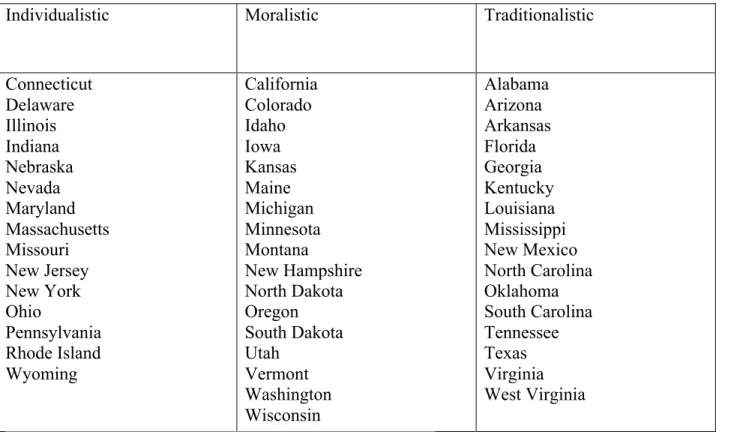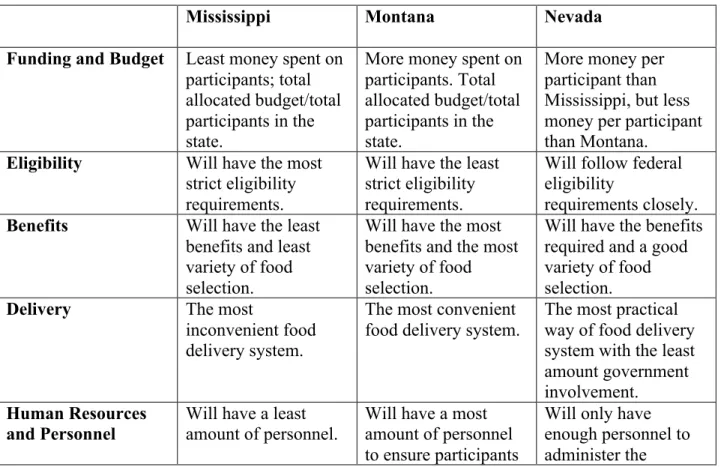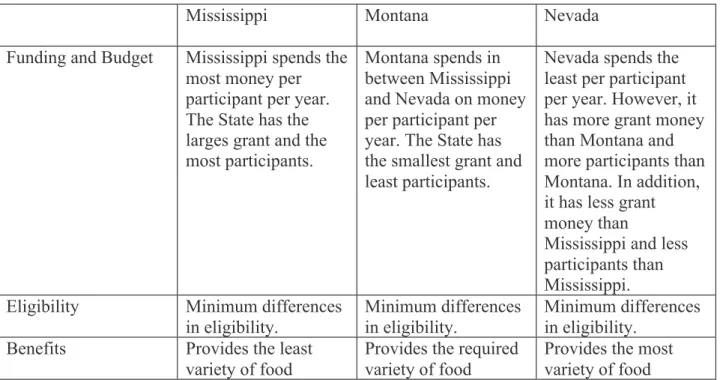Effects of Political Culture on the Administrative Functions of the Special Supplemental Nutrition Program for Women, Infants, and Children. This thesis examines the Special Supplemental Nutrition Program for Women, Infants, and Children (WIC) in three different regions that have different political cultures to better understand the influence of political culture on the administrative functions and characteristics of the WIC Program. The thesis will also use an administrative function framework to analyze whether a state's political culture has an effect on WIC's administrative function.
Alexis de Tocqueville was one of the first proponents of the idea of political culture in the United States. In his work, he defined political culture as "the particular pattern of orientation to political action in which every political system is embedded" (Elazar 1966, 78). Ira Shakansky was the first to test Elazar's theory in his work "The Utility of Elazar's Political Culture" (1969).
The purpose of this study is to use Elazar's political typology to compare administrative functions of the WIC program. The two types of allowable costs under the WIC program are "food costs" and "nutrition services and administration costs." The state agency may use food funds for the cost of obtaining supplemental food, storing supplemental food, or purchasing or renting breast pumps. Department of Agriculture has finalized the WIC program to further improve the nutrition and health of the nation's low-income pregnant women, new.
The WIC program has been successful in improving many aspects of participant life and health.

Methodology
However, states can regulate. eligibility standards, which I consider because such differences may affect the number of participants in each state's WIC Program. Next, this paper will discuss how WIC Program participants receive their benefits in each state and then compare the three. Next, I will look at the number of workers each state WIC Program has per participant in each state and compare the ratios of the three states.
Finally, I will examine the structure of each state's WIC Program by breaking down their organizational chart to determine whether the political culture in each state has an impact on the administration of the WIC Program. My primary research question is the following: Does the dominant political culture of a state affect the administrative implementation of the WIC Program in that state. Moralistic culture encourages support of the public good, which should encourage spending on the WIC Program.
So, I expect Montana will have lower income eligibility requirements, require less documentation for certification, and have a broader definition for nutritional risk. In terms of benefits, I expect Montana to have the largest variety of food benefits and offer additional benefits to their WIC program participants. In terms of distributing food benefits, I expect Montana to have the most accommodating and varied system for distributing benefits.
Given my research, I expect Nevada to have the most practical way to distribute the benefits, and the state government and regulatory authority will have little involvement in the process. Finally, I expect that Mississippi will have the least practical way to distribute food benefits because of the elites who control the government and their distance from the program's recipients. I expect that Montana, as a moralistic political culture, has a larger number of staff relative to the number of participants, to ensure.
Mississippi will have the lowest number of staff members due to the fact that Traditional political cultures tend to be instinctively anti-bureaucratic. Finally, for the structure of the programs, I expect Mississippi to have some head elites who authorize and manage the staff. I expect Montana's WIC program to have multiple leaders making decisions to improve the overall well-being of participants.

Findings
Since 2002, the Montana WIC program has operated the WIC Farmers' Market Nutrition Program (FMNP) in select locations. In addition, the Montana WIC program has several breast pumps available for breastfeeding mothers and babies. However, there are 11 full-time staff working in the state headquarters for the Montana WIC program.
The Montana WIC program is administered within the Montana Department of Public Health and Human Services. The program is not listed on the organizational chart, but the WIC program is in the Public Health and Safety section and is classified under the issue of Family Health. The Montana WIC program has a director and 11 full-time staff under the Family Community Health Bureau.
Preliminary data for fiscal year (FY) 2015 indicate that there are currently 74,200 participants in the Nevada WIC program (USDA WIC Preliminary Data FY. The Nevada WIC program provides nutrition education materials that keep pace with participants' personal and cultural preferences. Like the other states in the study, the Nevada WIC program provides breastfeeding support, education and counseling.
Like Montana, the Nevada WIC program uses a retail distribution system and since August 2009 has used EBT cards statewide. The Nevada WIC program has statewide coordinators who supervise WIC staff in county offices and clinics throughout the state. The Nevada WIC program is under the state Department of Health and Human Services and within the Division of Public and Behavioral Health (DPBH).
All applicants in the WIC program must meet categorical, income, location, and nutritional risk requirements. The Montana WIC program is under the Montana Department of Public Health and Human Services. The Montana WIC program has a director and 11 full-time employees under the Family Community Health Bureau.
Similar to Montana, the Nevada WIC program is under the Department of Health and Human Services. Finally, political culture produces minor observational differences about the administration of the WIC program.


